 Foreign medical graduates (FMGs), or international medical graduates (IMGs) represent an important section of the U.S. healthcare workforce. An IMG is a physician who received a basic medical degree from a medical school located outside the U.S. and Canada that is not accredited by a U.S. accrediting body, the Liaison Committee on Medical Education, or the American Osteopathic Association.1 According to the American Association of Medical Colleges, in 2021, 236,940 physicians actively working in the U.S. in all specialties combined were IMGs, roughly 25% of the physician population. When analyzing the internal medicine cohort, this number increased to 39.8% of 120,336 total active internists.2 With roughly 48,000 internal medicine specialists working in the U.S. healthcare system, a discussion regarding the role and impact of foreign medical graduates has arisen in academic circles. In this article, we provide a summary of these discussions and explore the individual experiences of four international medical graduates who currently work as hospitalists in the U.S.
Foreign medical graduates (FMGs), or international medical graduates (IMGs) represent an important section of the U.S. healthcare workforce. An IMG is a physician who received a basic medical degree from a medical school located outside the U.S. and Canada that is not accredited by a U.S. accrediting body, the Liaison Committee on Medical Education, or the American Osteopathic Association.1 According to the American Association of Medical Colleges, in 2021, 236,940 physicians actively working in the U.S. in all specialties combined were IMGs, roughly 25% of the physician population. When analyzing the internal medicine cohort, this number increased to 39.8% of 120,336 total active internists.2 With roughly 48,000 internal medicine specialists working in the U.S. healthcare system, a discussion regarding the role and impact of foreign medical graduates has arisen in academic circles. In this article, we provide a summary of these discussions and explore the individual experiences of four international medical graduates who currently work as hospitalists in the U.S.
Literature review
We performed a brief review of a convenience-based selection of the literature using MEDLINE with the keywords “International Medical Graduates”, “IMG”, “Foreign Medical Graduates”, and “FMG”. Our focus was publications studying IMGs based in the U.S., exploring their experiences as foreigners in a new country, and debating the impact of IMGs on the healthcare system.
A meta-analysis of qualitative studies performed by Al-Haddad, et al. in 2022 provides an overview of the general experiences of IMGs with migration and adaptation to new systems.3 In this review, which included 46 individual studies, a total of 1,142 IMGs from low-, medium-, and high-income countries were interviewed. Five argumentative lines used by IMGs to describe their personal experiences were identified. These lines represent the overall journey that IMGs undertake when migrating from their country of origin, from a comparison between countries (Migration Dimension), to initial difficulties including loss, shock, and barriers of entry into the profession (A Challenging Start), followed by language barriers, cultural differences, and medical education differences (Degree of Dissonance), before getting support and resources to overcome these barriers (Leveling the Playing Field), and adapting to the new environment (Survive Then Thrive).
Another publication explored the intercultural challenges faced by IMGs when arriving in a new country.4 Published by Michalski, et al. this meta-analysis included 47 studies, 18 of them studying IMGs migrating to the U.S., and identified that papers dealing with IMGs usually mention topics related to communication (with patients, relatives, and other healthcare workers), the healthcare system, immigration, racism, and discrimination, as well as gender issues. Mentions of “healthcare system” and “language” were almost exclusively negatively connotated. The study identified “patient-centered care,” “language,” “healthcare system,” and “immigration process” as the areas in which IMGs had more trouble adapting, and “shared decision-making,” “lower hierarchy and loss of status,” “medical education,” and “separation of relatives” as being significantly different from their country of origin.
A narrative review by Ranasinghe highlights how, although IMGs play an active role in the full spectrum of healthcare services, 41% of practicing IMGs are in primary care disciplines and are more likely to practice in areas and specialties with a U.S. medical graduate shortage.5 The author concludes that IMGs take up opportunities to practice within patient populations that face difficulties secondary to an uneven distribution of the physician workforce.
Moreover, several opinion pieces have underlined the importance of IMGs in the U.S., with some specialties even being described as “IMG-dependent” by some authors. There is a growing debate regarding the ethics of a healthcare system that trains an increasing number of foreign graduates to serve its population, arguing that doing so supports a “brain-drain” from developing countries.6-8
This brief review highlights two distinct focuses regarding the study of the IMG experience. On the one hand, researchers seem interested in understanding the reasons behind IMGs’ academic migration, the hardships they endure once in the new country, the difficulties they experience when entering the new health system, and how to improve their chances of smoother integration. On the other hand, the debate regarding the ethics of IMG training underlies their importance in the U.S. healthcare system, as well as the consequences of depleting low- or middle-income countries of healthcare professionals.
However, no publication was identified regarding the impact of the cultural exchange that IMGs bring to host institutions. Additionally, no studies were found regarding how the relationship between IMGs and their home country, their host country, and their medical practice changes due to academic migration.
With this in mind, we asked our four IMGs to talk about their experiences of migration to further delve into this multidimensional topic.
The home country
Before exploring the intricacies of medical migration to the U.S., we questioned the interviewees about their country of origin, specifically as it relates to their medical training and the overall experience of providing healthcare in that setting. When talking about their medical training in their home country, the physicians interviewed took different approaches.
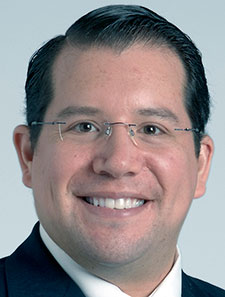
Dr. Auron
Moises Auron, MD, an academic med-peds hospitalist at the Cleveland Clinic, and a professor of medicine and pediatrics at the Cleveland Clinic Lerner College of Medicine of Case Western Reserve University in Cleveland, shared how his interest in academic medicine stems from his education in Mexico. “They keep publishing, they keep presenting, and they keep teaching. It doesn’t stop,” he said. “That’s what I learned in Mexico, both at the Salvador Zubirán Institute and at the General Hospital of Mexico City, because at the General Hospital, I also saw how the residents were sending papers and working on research projects. That was influential to me.”
He said the opportunities he had as a student at the National Autonomous University of Mexico, or UNAM, were extensive, “I had a lot of mentors. At UNAM, they give you the opportunity to be an instructor of pretty much all disciplines (histology, embryology, anatomy, biochemistry, surgery, etc.). They give you the opportunity to do research (basic, translational, clinical) and present in local, national, and international meetings, as well as publish. They give you the opportunity to do things they think will make your CV very competitive. If you are a Mexican student who is enthusiastic, motivated, and engaged, who is putting in the effort, who is well involved, who takes advantage of all the opportunities that the school has, who goes with your mentor, who stays to do things, who becomes a teaching assistant/instructor, you [will have] all the resources to be extremely competitive. Every effort—presenting at a medical meeting, doing research, has tremendous curricular value—for example, even presenting a poster at a conference as a medical student, even if it is a local conference, people have no idea the tremendous [curricular] value it has.”
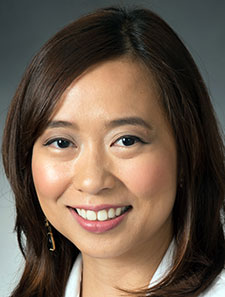
Dr. Santos
Similarly, Patricia Santos, MD, MBA, an assistant professor of medicine at the division of hospital medicine, and the associate chief of quality and the safety chair for the hospital medicine division and the oncology co-management service at the Albert B. Chandler Hospital at the University of Kentucky in Lexington, Ky., said going to medical school in the Philippines led her to experience first-hand the elevated cost of healthcare. “I think it’s [the] exposure in my medical training [that made me resourceful],” she said. “I think it’s [the] experiences, the patient experiences where you learn how to be resourceful and really try your best to think through things in terms of how to get the care that the patient needs given what you have.”
In relation to the perception of the healthcare system of their country of origin, the physicians reflected on working in low-resource settings. Dr. Santos said, “In the Philippines, you really have to have a really high pre-test probability when you’re considering a disease before you do all the diagnostic tests, because the patient may not be able to afford all the tests that you want.”
This impacts the way physicians interact with medical information. “Since there were not enough resources [In Mexico] when I was there 20 years ago, people had to memorize more [medical information] because it depended on them [to know],” Dr. Auron said. “Despite the shortage of resources, [Mexican] physicians provided excellent medical care.”
These experiences, it seems, begin early in their medical education. “I distinctly remember when I was a medical student, you know we had this patient who told us ‘Oh … our medical bill is very high, would it be possible for you to tell me first if you’re going to order something? We want to know how much it is going to be.’ And that stuck with me,” Dr. Santos said. “Because we had to take care of patients considering that there is like a cost to their care and we have to work with them to [provide them with] good care [while making sure not to] drain their resources, their financial health.”
The impact of migration
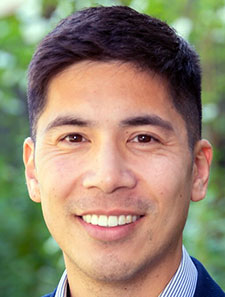
Dr. Tse
Our second discussion topic explored the impact that academic migration to the U.S. has on IMG hospitalists. Two of the interviewees talked about this as a positive experience, one that led them to grow both personally and professionally. Gabriel Tse, MD, faculty in the division of pediatric hospital medicine at Lucile Packard Children’s Hospital, Stanford University School of Medicine in Stanford, Calif., said, “Talking about how we might approach the patient in another country helps me [understand] that there’s not just one way of doing things. That’s [more of a soft skill and is a] bit more difficult to express or to quantify, but I think that’s also a very important thing. … I think the clinical knowledge was a value add. Just seeing different health systems and seeing different [ways] of providing clinical service is really interesting.” Dr. Tse completed his pediatrics residency at the University of Toronto and his pediatric hospital medicine fellowship at Stanford University.
Dr. Auron had a similar experience. “Every hospital has different systems, they have different opportunities to manage patients, you [meet] doctors who have different [strengths], ranging from clinical experience to more academic doctors, and those who have experience with more complex patients,” he said. “By exposing yourself to different systems, your management of patients is more comprehensive. The secret is that you end up going out more and studying more. You study based on the problems you are seeing, based on the things you are focusing on, and your medical management is based on the experience of the doctor who is supervising you.”
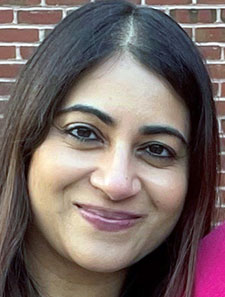
Dr. Joseph
Interestingly, Priya Joseph, MD, the specialty medical director for Carolinas Hospitalist Group at Atrium Health Carolinas Medical Center in Charlotte, N.C., thinks otherwise about any changes in herself after migrating to the U.S. “I think the higher training and financial independence definitely made me much more self-confident,” she said. “My self-confidence significantly improved. I also … have a more wholesome approach to patients than even when I was in India, because … I’m taking care of them, so there’s a greater level of accountability with patient care. When you’re in training you feel like your supervisor or your attending is the one who is responsible, [and] now there’s just a greater sense of responsibility that you feel. That’s probably the big change. I’m not sure it’s related to the migration per se. I think it’s just related to having higher training and feeling self-reliant.”
Drs. Auron, Tse, Santo, and Joseph all said adapting to the U.S. healthcare system was a challenge—the administrative load, healthcare waste, and how practices around waste differ between the U.S. and other countries, were just some of the issues. Dr Joseph provided some tips on how best to navigate this process. “Number one is to be prepared to work hard and to keep your ears open because there is so much to learn and so much to absorb. Number two is to be flexible and adaptive in your environment. Don’t think ‘Oh, I can’t do this’. Be just like a dry sponge and soak it all in. I think that’s what has helped.”
For IMGs, being accepted into a medical residency also implies moving to a different country, with a different culture and a different language. The IMGs commented on how living in a different setting also shaped their personal lives. “I think it was just going through so much change, you know. [By] putting oneself through challenging situations and [just] like running a marathon, it’s how much you train for it that [makes you] succeed. The more you train, the more you push yourself, the more [chances you have at being] successful at completing a marathon, and I compare it to that,” Dr. Joseph said. “I don’t think it’s the actual structure of education in India. I think it was more the experience of having gone through the discomfort of moving to another country, learning a different culture, learning how to interact with patients in a different way.”
Dr. Tse had a similar experience. “There were lots of challenges in the first six months of me moving there, but I grew a lot personally. I met a lot of great people and I felt more international. I felt outside of this bubble. It was a great opportunity to grow up quickly, having gone abroad.”
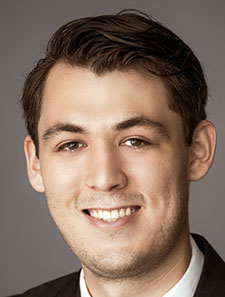 Nikolai Emmanuel Bayro Jablonski is a medical graduate of Universidad de Guadalajara, Nuevo Hospital Civil de Guadalajara Juan I. Menchaca, Guadalajara, Jalisco, México. He would like to thank Diana Paulette Evans, MD, MSc for her assistance in the interview process for this article.
Nikolai Emmanuel Bayro Jablonski is a medical graduate of Universidad de Guadalajara, Nuevo Hospital Civil de Guadalajara Juan I. Menchaca, Guadalajara, Jalisco, México. He would like to thank Diana Paulette Evans, MD, MSc for her assistance in the interview process for this article.
Read Part II in the December issue here.
References
- American Academy of Family Physicians. Residency application requirements for international medical graduates. AAFP website. https://www.aafp.org/students-residents/medical-students/become-a-resident/applying-to-residency/international-medical-graduates.html. Accessed October 4, 2024.
- Association of American Medical Colleges. Physician specialty data report: active physicians who are international medical graduates (IMGs) by specialty, 2019. AAMC website. https://www.aamc.org/data-reports/workforce/data/active-physicians-who-are-international-medical-graduates-imgs-specialty-2019. Accessed October 4, 2024.
- Al-Haddad M, Jamieson S. International medical graduates’ experiences before and after migration: A meta-ethnography of qualitative studies. Med Educ. 2022;56(5):504-15.
- Michalski K, Farhan N, et al. Dealing with foreign cultural paradigms: A systematic review on intercultural challenges of international medical graduates. PLoS One. 2017;12(7):e0181330. doi: 10.1371/journal.pone.0181330.
- Ahmed AA, Hwang WT, et al. International medical graduates in the US physician workforce and graduate medical education: current and historical trends. J Grad Med Educ. 2018;10(2):214-8.
- Cohen JJ. The role and contributions of IMGs: a U.S. perspective. Acad Med. 2006;81(12 Suppl):S17-21. doi: 10.1097/01.ACM.0000243339.63320.98.
- Mandel J. Counterpoint: Should the United States provide postgraduate training to international medical graduates? No. Chest. 2016;149(4):895-7.
- Pinsky WW. the importance of international medical graduates in the United States. Ann Intern Med. 2017;166(11):840-1.
Hey Nikolai, this is a beautifully written piece; I can’t wait for the second part. Stay tuned for the new IMG in Hospital Medicine SIG. I would love to hear more stories about our wonderful IMGs and their experiences in the US healthcare system.
Hi Amy, Thank you so much for your kind message. I hope the second part doesn’t disappoint! I am very excited for the IMG SIG you referred to, and will gladly participate in any way possible.